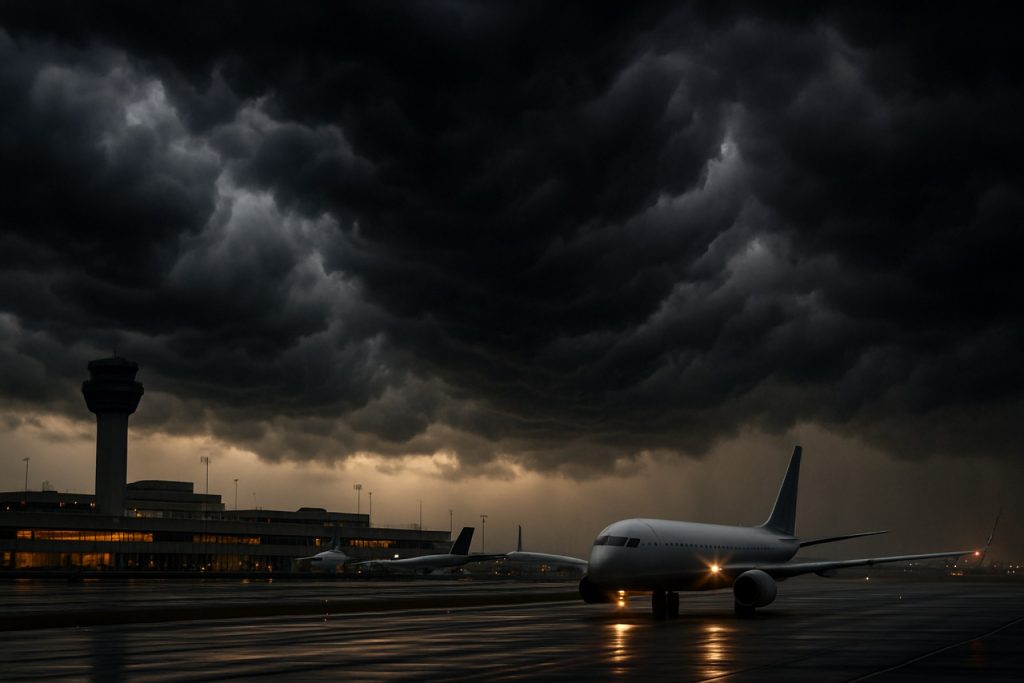
- Repeated radio blackouts at major U.S. airports have endangered communication between pilots and air traffic controllers.
- Incidents, including at Newark, Denver, La Guardia, and Chicago Midway, have intensified concerns about safety in busy airspaces.
- The FAA responded by capping flights at Newark through summer and fall to ease pressure and improve safety.
- Experts stress the need for operational vigilance, investment, and updated technology to prevent future incidents.
- Passengers’ trust hinges on restoring reliable communication and reinforcing safeguards throughout the national airspace system.
Newark Liberty International Airport hummed with anticipation yesterday, as jet engines revved and travelers clutched boarding passes tightly, eyeing departure boards. Suddenly, the seamless ballet of takeoffs and landings gave way to an unexpected void: radio silence. Air traffic controllers—a city’s unseen custodians of safety—lost all contact with airborne aircraft for the fourth time in less than a month. Pilots entered a world of uncertainty, guiding hundreds of souls across cloud-veiled skies utterly alone.
This eerie disconnect echoes a wider chorus of unease. Just last week, a nerve-wracking 90 seconds slipped by in Denver as controllers and planes were left in the dark, time stretching with every unanswered attempt at communication. On the tinderbox runways of La Guardia and Chicago Midway, brushes with disaster have grown uncomfortably frequent, raising urgent questions among experts and the flying public alike.
- Why are these blackouts multiplying in America’s busiest airspaces?
- What steps are authorities taking to prevent catastrophe?
- How safe is your next flight, really?
The Federal Aviation Administration (FAA), the nation’s aviation gatekeeper, responded decisively this morning. Their new strategy: a substantial capping of flights at Newark for much of the scorching summer and brisk fall—a hard reset on the skies above the Garden State. The move aims to cool the feverish pace, carving out breathing room for both people and systems, as the industry scrambles to diagnose and cure these invisible breakdowns.
David Grizzle, former chief operating officer of the FAA’s Air Traffic Organization and an aviation executive veteran, underscores the peril and complexity of the moment. “Every incident is a wakeup call. It’s about vigilance, investment, and a relentless focus on operational discipline and cutting-edge technology,” he stresses. The invisible threads of radio-frequency and discipline that stretch from control tower to cockpit must remain unbroken, lest everything slip beyond reach in a flash.
For millions of Americans boarding flights this season, the underlying story isn’t just one of inconvenience or delay—it’s about trust. Passengers rely on a hidden, precisely tuned symphony of professionals safeguarding their journey every second. That harmony has been rattled, and a nation looks on, waiting for the FAA and its leaders to steer us safely back from the edge.
- What safeguards are now in place after repeated communication blackouts?
- Could similar incidents affect other airports soon?
- What role does modern technology play in keeping our skies safe?
To learn more about safety initiatives and real-time updates, visit the Federal Aviation Administration.
Shocking Secrets: The Alarming Pros & Cons of Flight Caps at Major US Airports
-
Pro: Increased Safety for Passengers and Crews
By capping flights at Newark Liberty International Airport, the Federal Aviation Administration aims to reduce congestion and ease the workload on stressed air traffic controllers, especially after repeated radio blackouts. This move prioritizes safety over speed or convenience.
-
Con: Travel Disruptions and Economic Impact
Reducing flight volumes could mean more delays, higher ticket prices, and ripple effects across airlines and the wider economy. Travelers may find themselves dealing with sold-out flights or longer wait times throughout the busy summer and fall.
-
Controversy: Underlying Infrastructure Flaws
The recent failures highlight persistent issues in air traffic communications infrastructure. Despite assurances from the Federal Aviation Administration, experts question whether enough is being done to modernize outdated systems and prevent repeat incidents at other busy hubs.
-
Limitation: Temporary Fix or Lasting Solution?
Many wonder if flight capping is just a short-term patch rather than a comprehensive fix. Without substantial investment and innovation—which the Federal Aviation Administration has promised, but not detailed—risks may simply resurface elsewhere or later.
-
Controversy: Transparency and Trust
The frequency of these blackouts has shaken public confidence. The effectiveness of the Federal Aviation Administration‘s communication and crisis management is under scrutiny, raising questions about accountability and the accuracy of official reassurances.
You Won’t Believe What’s Coming Next for Air Traffic Safety: Bold Predictions Revealed!
-
Accelerated Modernization of Communication Systems:
In response to mounting communication blackouts, the aviation industry is projected to invest heavily in next-generation radio and digital communication upgrades. Expect fresh initiatives announced by the Federal Aviation Administration to foster redundancy and real-time failovers, making total radio silences a thing of the past.
-
Wider Shift Toward AI-Driven Safety and Monitoring:
Artificial intelligence and advanced analytics will increasingly monitor air traffic patterns and controller performance, helping predict and prevent malfunctions before they escalate. The FAA and major airports are set to accelerate the implementation of AI-powered diagnostic tools in the coming years.
-
Flight Caps as the New Normal:
Temporary restrictions on takeoffs—like those seen at Newark—may become a standard playbook for busy airports experiencing technical strain. Look for formal frameworks from authorities such as the Federal Aviation Administration standardizing when and how this strategy will be applied nationwide to avoid systemic collapses.
-
Industry-Wide Safety Reviews and Audits:
Regular, nationwide safety audits will grow in frequency and depth, as public pressure mounts and oversight tightens. Partnerships between the FAA, airlines, and independent safety boards are predicted to expand, promising greater transparency and accountability across the sector.
-
Strengthened Training and Staffing Initiatives:
Efforts to address controller fatigue and staffing gaps will intensify, with more funding directed to recruitment, training, and mental health resources. This prioritization, championed by the Federal Aviation Administration, is expected to ensure resilience even in the face of growing air travel demand.



